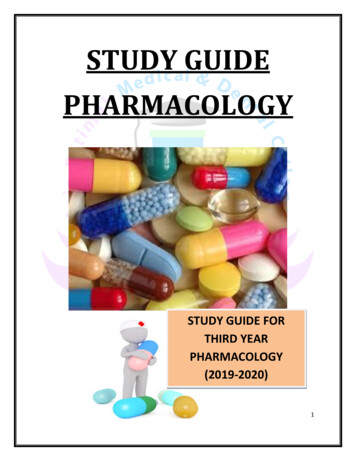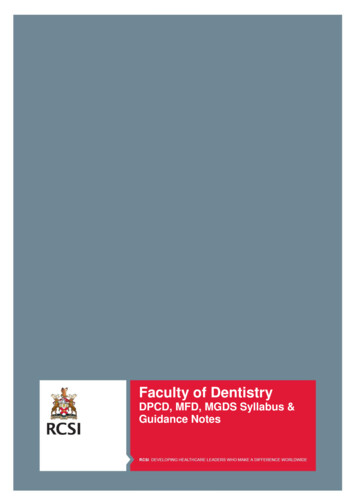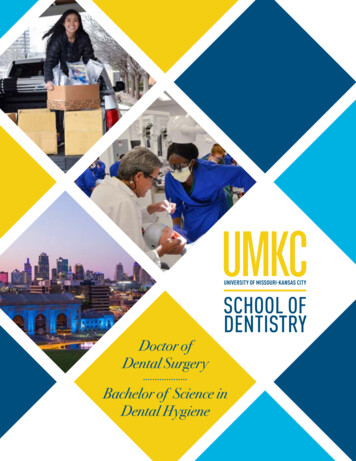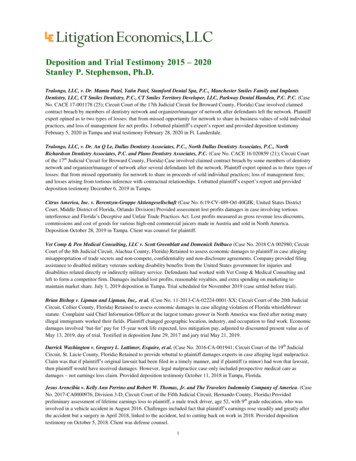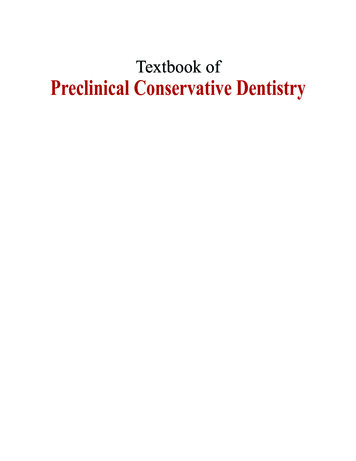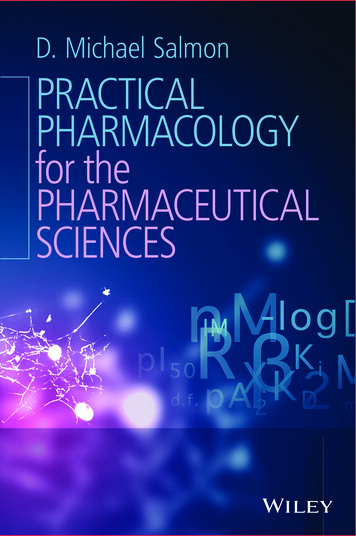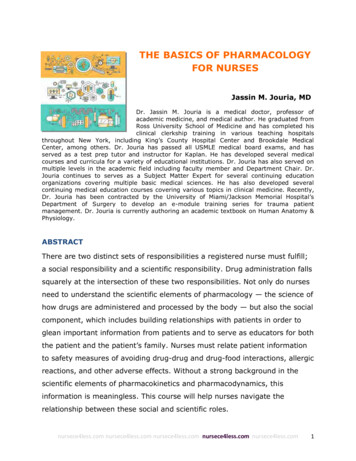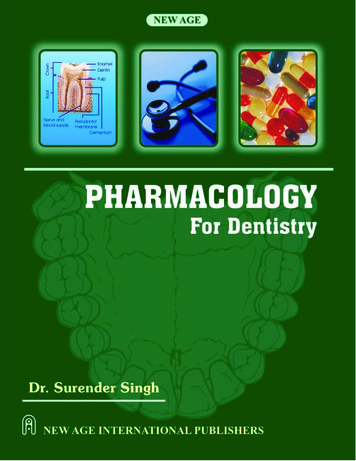
Transcription
This pageintentionally leftblank
Copyright 2007, New Age International (P) Ltd., PublishersPublished by New Age International (P) Ltd., PublishersAll rights reserved.No part of this ebook may be reproduced in any form, by photostat, microfilm,xerography, or any other means, or incorporated into any information retrievalsystem, electronic or mechanical, without the written permission of the publisher.All inquiries should be emailed to rights@newagepublishers.comISBN (13) : 978-81-224-2556-7PUBLISHING FOR ONE WORLDNEW AGE INTERNATIONAL (P) LIMITED, PUBLISHERS4835/24, Ansari Road, Daryaganj, New Delhi - 110002Visit us at www.newagepublishers.com
This pageintentionally leftblank
PrefacePharmacology has undergone major intellectual changes in the recent years and has becomeincreasingly important to all medical, dental and other health professionals. The graduatestudents of dentistry may have to handle medical emergency during various dentalprocedures on the dental chair. Besides this, dentists have to look into various drugassociated interactions. The broad goal of teaching pharmacology to undergraduatestudents is to inculcate rational and scientific basis of therapeutics keeping in view thedental curriculum and profession. A sincere attempt has been made to present a completetext for undergraduate students of dentistry as per the new syllabus requirement (DentalCouncil of India, BDS course regulation, 2006).The book is divided into thirteen sections, initial sections cover the general andautonomic pharmacology, followed by other sections of drug acting on different bodysystems. A detailed section is devoted only to dental pharmacology which covers all agentsused in pharmacotherapy of dental conditions. The last section covers vaccine, sera andother immunological agents and drugs used in skin disorders. The chapters have beenarranged in such a way that knowledge gained from initial chapters will be helpful tostudents for understanding subsequent chapters. The appendix contains the list of newlyapproved and banned drugs in India.The classification adopted in the books provides pharmacological distinction amonglatest drugs with doses and routes of administration along with leading trade name(s)available in Indian market, but it should not be construed as the recommendation of thoseparticular brands.
(viii)Thanks are due to New Age International (P) Ltd., N. Delhi for their keen interest andattention in bringing out this book in its present form. Further, I am indebted to all myfriends and well wishers for their support and encouragement.I would like to express my gratitude and indebtedness to all my family members fortheir sacrifice, affection and inspiration throughout the present work.New DelhiSurender Singh
(ix)ContentsPreface(vii)SECTION 1General Principles of Pharmacology1.1 Sources and Nature of Drug Dosage Form31.2 Prescription Writing151.3 Rational Use of Drugs & Drug Laws191.4 Pharmacokinetics(Absorption, Distribution, Metabolism and Excretion of Drugs)251.5 Pharmacodynamics (Mode of Action of Drugs)391.6 Adverse Drug Reactions471.7 Drug Interactions51SECTION 2Drugs Acting on CNS2.1 General Anaesthetics2.2 Sedative & Hypnotics61692.3 Narcotic Analgesics (Opioids)2.4 Non-Narcotic Analgesics (NSAID’s)7583
(x)2.52.62.72.82.92.10Psychotropic AgentsAntiepileptic AgentsMuscle RelaxantsLocal AnaestheticsCNS StimulantsDrugs Used in Parkinsonism95105111115119123SECTION 3Drugs Acting on ANS3.13.23.33.43.5Sympathomimetics (Adrenergic Agents)Treatment of Shock & Vasopressor AgentsSympatholytics (Antiadrenergic Agents)Parasympathomimetics (Cholinergic Agents)Parasympatholytics (Anticholinergic Agents)131141145155161SECTION 4Drugs Acting on Cardiovascular & Urinary System4.14.24.34.44.54.64.7Cardiotonics (Cardiac Glycosides)Antihypertensive AgentsAntianginal AgentsAntiarrhythmic AgentsAntihyperlipidemic AgentsPlasma ExpandersDiuretics and Antidiuretics169175185189195199203SECTION 5Autacoids5.15.25.35.4Histamine and Antihistaminic AgentsSerotonin and its AntagonistsProstaglandins and LeukotrienesDrugs Used in Cough and Asthma215221225229
(xi)SECTION 6Drugs Acting on Blood6.16.2COAGULANTS AND ANTICOAGULANTSHAEMATINICS (Drugs Used in Anaemia)239247SECTION 7Drugs Acting on GIT7.17.27.3Laxatives and Antidiarrhoeal AgentsEmetics & Antiemetic AgentsAntacids and Antiulcer Agents253257261SECTION 8Drugs Acting on Endocrine System8.18.28.38.48.5Anterior Pituitary HormonesAntidiabetic AgentsGlucocorticoids & Sex HormonesThyroid Hormone & Antithyroid AgentsHormonal Contraceptives269275281293297SECTION lfonamides, Nitrofurans and QuinolonesTetracyclines, Chloramphenicol and Chemotherapy of UTIBeta Lactam AntibioticsAminoglycosides AntibioticsMacrolide and Polypeptide AntibioticsAntiviral AgentsAntifungal AgentsAntimalarial AgentsAntiamoebic and other Antiprotozoal DrugsAnthelmintic AgentsChemotherapy of Tuberculosis303311317327331337343349355361365
(xii)9.12 Chemotherapy of Leprosy9.13 Chemotherapy of Malignancy369371SECTION 10Vitamins and Trace Elements10.1 Vitamins and Trace Elements383SECTION 11Chelating Agents & Treatment of Poisoning11.1 Chelating Agents & Treatment of Poisoning395SECTION 12Dental s & DisinfectantsAstringent and ObtundentsMummifying and Bleaching AgentsStyptics (Local Haemostatics) and Disclosing AgentsDentifrices and Mouth WashesCaries and FluoridesPharmacotherapy of Common Oral Conditions & Dental Emergencies407413415417419423425SECTION 13Miscellaneous13.1 Vaccines, Sera and Other Immunological Agents13.2 Drugs Used in Skin Disorders431449APPENDICESAppendix I : List of Recently Approved New Drugs and Combinationsin India (During 1999-July 2006)Appendix II : List of Banned Drugs and Fixed Dose Combinationsin India (Updated till January 2007)Index459473477
Section 1General PrinciplesofPharmacology
This pageintentionally leftblank
rreettppaCChh1.11.4Sources and NatureofDrug Dosage FormINTRODUCTIONPharmacology (derived from Greek words,pharmacon-drug; logos-discourse in) consistsof detailed study of drugs – its source, physical and chemical properties, compounding,biochemical and physiological effects, pharmacodynamics (its mechanism of action),pharmacokinetics (absorption, distribution,biotransformation and excretion), therapeutic and other uses of drugs.According to WHO definition ‘Drug isany substance or product that is used orintended to be used to modify or explorephysiological system or pathological statesfor the benefit of the recipient’.Pharmacology has some major subdivisions:Pharmacodynamics is the study of thebiochemical and physiological effects of thedrugs and their mechanism of action.Pharmacotherapeutics deals with theuse of drugs in the prevention and treatmentof diseases and it utilizes or depends uponthe information of drug obtained bypharmacodynamic studies.Pharmacokinetics deals with thealterations of the drug by the body whichincludes absorption, distribution, binding/storage, biotransformation and excretion ofdrugs.Toxicology deals with the side/adverseeffects and other poisonous effects of drugs,since the same drug can be a poison,depending on the dose.Chemotherapy deals with the effects ofdrugs upon microorganisms and parasiteswithout destroying the host cells.Pharmacology also includes certainallied fields as:Pharmacy is the science of preparation,compounding and dispensing of drugs. It isconcerned with collection, identification,purification, isolation, synthesis and standardization of medicinal /pharmaceuticalsubstances.Pharmacognosy deals with the study ofthe sources of drugs derived from plants andanimal origin.
4Section 1/ General Principles of PharmacologyMateria-medica: This is an older termand deals with the source, description(physical and chemical properties) andpreparation of drugs.Pharmacopoeia is an official referencecontaining a selected drugs/medicinalpreparations with their description, tests fortheir identity, purity and potency and with theiraverage doses. A few famous pharmacopoeiaand other reference books are the IndianPharmacopoeia (IP), the British Pharmacopoeia(BP); the United States Pharmacopoeia (USP);the British Pharmaceutical Codex (BPC); theNational Formulary (NF) i.e. British NationalFormulary (BNF) and National Formulary (NF)of India. It is necessary for understanding theeach aspects of pharmacology by dentists, asthey have to prescribe the drug for the treatmentof various dental conditions in general andother concurrently disease with many of thedental patients. The dentists should be awareof drug interactions and capable of handle anyemergency during any dental procedure. Belladonna (Atropa belladonna): Atropine group. Pilocarpus sp.: Pilocarpine. Vinca (Vinca rosea): Vincristine,vinblastine. Rauwolfia serpentina (root): Reserpine. Coca (Erythroxylum coca): Cocaine.ii. Glycosides are ether like organicstructure combined with sugars, thenon-sugar component called aglyconeor genin. The important glycosides are: Digitalis (Digitalis purpurea, Digitalislanata): Digoxin etc. Stropanthus (Stropanthus kombe):Stropanthin etc. Senna (Cassia acutifolia): Sennoside etc.iii. Oilsa. Fixed oils are glycerides of oleic, palmiticand stearic acids. Mostly fixed oils areedible and used for cooking. The fixedoils used as drug are: Castor (Ricinus communis): Castor oil.SOURCES OF DRUGS Olive (Olea europaea): Olive oil.‘Drug’ is derived from French word ‘drogue’means a dry herb. Drugs are obtainedmainly from plants, animals, microbes andmineral sources, but a majority of them thatare used therapeutically are from syntheticor semi-synthetic products. Cocoa butter (Theobroma cacao):Theobroma oil used as emollientin skin cream and making suppositories.PLANT ORIGINThe pharmacologically active components in vegetable drugs are:b. Volatile oil or essential oil containsthe hydrocarbon terpene. Theimportant volatile oils are: Turpentine oil, from species ofpines, used as a counterirritant.i. Alkaloids are basic substancescontaining cyclic nitrogen. Theimportant alkaloids are obtained from: Opium (Papaver somniferum): Morphine group. Cinchona (Cinchona officinalis): Quinine etc. Cod liver oil and shark liver oil:Rich source of vitamin A and D. Lemon oil (from Citrus limon), usedas flavouring agent. Peppermint, cardamom and fennel used as carminative andflavouring agent.
Sources and Nature of Drug Dosage Form Oil of clove is mainly useful inrelieving pain in toothache.iv. Resins are produced by oxidation andpolymerization of volatile oils. Thedifferent types of resins are: Oleoresins: Male fern extract usedfor tapeworm infestation. Gum resins: Asafoetida, used ascarminative and antispasmodic. Oleo gum resin: Myrrh, it has a localstimulant and antiseptic propertiesand generally used in mouthwash. Balsams: Benzoin, used internallyas expectorant and externally asastringent. Balsam Tolu, used as stimulatingexpectorant.v. Gums are the secretory products ofplants. On hydrolysis they yield simplesugar like polysaccharides. They arepharmacologically inert substancesand mainly employed as suspendingand emulsifying agent in variouspharmaceutical products.The widely used preparations are gumacacia and tragacanth.vi. Tannins are nonnitrogenous constituents of plant. Chemically they are phenolic derivatives and are characterizedby their astringent action. Tannins aregenerally employed in the treatment ofdiarrhoea and burns. The importantplants which contains tannins are:Amla, Behera, Hirda (in combinationform ‘Triphala’), Black catechu andAshoka bark.ANIMAL SOURCESThe different animal products afterpurification in a suitable dosage form for thetreatment of disease are listed in table 1.1.1.5FROM HUMAN BEINGThere are certain products which areobtained from human being e.g. Immunoglobulins: From blood. Placental extract: From placenta. Chorionic gonadotropin: From urineof pregnant women. Growth hormone: From pituitarygland.FROM MICROORGANISMSThe different classes of drugs obtained/isolated from microbes are: Penicillin: Penicillium chrysogenumand notatum (Fungus). Streptomycin: Streptomyces griseus(Actino-mycetes). Erythromycin: Streptomyces erythreus(Actinomycetes). Chloramphenicol: Streptomycesvenezuelae (Actinomycetes). Tetracyclines: Streptomyces aureofaciensand rimosus (Actinomycetes). Polymyxin B: Bacillus polymyxa. Bacitracin: Bacillus subtilis. Nystatin: Streptomyces nouresi. Griseofulvin: Penicillium griseofulvum.Apart from various other antibioticsobtained from microorganisms, there areother products that are also produced bymicroorganisms. They are: Streptokinase, an enzyme from grampositive cocci (Streptococcus pyogenes). Vitamin B 12 (cyanocobalamin):Streptomyces griseus.
6Section 1/ General Principles of PharmacologyTable 1.1.1: Classification of different animal products used as drug and surgicals.DrugCategoryAnimal sourceInsulinThyroid extract/thyroxineShark liver oilCod liver oilAntisnake venomHyaluronidasePepsinHormoneHormoneVitamin AVitamin A and DImmune serumEnzymeEnzymePancreas of beef or pigThyroid glandLivers of shark and allied speciesLivers of Gadus speciesBlood of horseTestis of bullStomach of beef and pigSurgical ligatures and suturesUsed in surgeryIntestinal tissues, tendons of animals.ROUTES OF DRUG ADMINISTRATIONThe drugs can be administered by a varietyof routes, either locally or administered orallyand by injection. To produce local effects,drugs are applied topically to the skin ormucous membranes. To produce systemiceffects drugs are administered orally, rectally,parenterally or by inhalation route.The choice of the route in a givensituation depends upon the drug and thepatient’s condition (e.g. in unconscious andvomiting state), and urgency of treatment(whether the routine treatment or inemergency condition).The important routes of administrationare:LOCAL ROUTESThe dosage forms applied locally to theskin are powders, paste, lotions, ointments,creams, plasters and jellies. They are usedfor their antiseptic, antipruritic, analgesic,local anaesthetic and other related effects.The absorption of drug through the skinis proportional to the surface area coveredand to their lipid solubility. The dermis layeris freely permeable to many fluids.Inflammatory and other related conditionswhich increase the cutaneous blood flowalso enhance absorption of drugs.Absorption through the skin can beenhanced by induction (rubbing the oilyvehicle preparation into the skin) also.On the skin, drug is applied in the formof ointment, cream, lotion, paste, plaster,powder etc.The topical application is also used onthe mucous membranes i.e. nose, throat, eye,ear, bronchi, rectum, urethra, vagina andrectum.In case of mouth and pharynx, the drugis used in the form of throat paints, lozenges,gargles or mouth washes.In case of corneal application (in theform of ointments, drops), the drug maypenetrate the anterior chamber and affect theciliary muscle. The nasal mucosa is treatedwith drug solution in the form of spray orirrigation.The bronchial mucosa and lungs aretreated with inhalations, aerosols (in the formof fine powder with the help of nebulizer) e.g.salbutamol (ASTHALIN) inhaler.
Sources and Nature of Drug Dosage FormDrugs may also be administered locallyin the form of bougies, jellies for urethra,pessaries, vaginal tablets, creams anddouches for vagina and suppositories forrectal administration.Due to the rich blood and lymph supplyto rectum the unionised and lipid solublesubstances are readily absorbed from therectum. The advantages of this route arethat gastric irritation is avoided and easyadministration by the patient himself.Administration of drug in the form ofliquid into the rectum is called enema,which may be soap water or glycerinevegetable oil. It is used to remove thefaecal matter and flatus and isused in constipation. Certain drugs areadministered rectally for producingsystemic effects also (e.g. aminophylline,indomethacin, paraldehyde etc.).SYSTEMIC ROUTESThe drug administered throughsystemic routes (orally or parenterally), isabsorbed into the blood, distributed alongthrough the circulation and produce theirdesired effects.Oral RouteThis is the most commonly used routefor drug administration. It is also the safest,most convenient and economical. But, thereare some limitation of this route: Drug action is slow, thus not suitablefor emergencies. Incapability to absorb some drugs, dueto their physical characteristics i.e.polarity of the drug.7 Unpalatable and other irritant drugscan not be administered. Can not be used for unconscious anduncooperative patient. May not be useful in the presence ofvomiting and diarrhoea. Drugs, which can be destroyed by digestive juices (i.e. insulin, penicillinG) or in liver (i.e. testosterone, nitroglycerine) can not be administeredorally. The absorption of certain drugs isnegligible e.g. streptomycin.Enteric Coated TabletsThe drugs which are destroyed bythe gastric juices in the stomach, arecoated with keratin, shellac and celluloseacid phosphate. These substances are notdissolved by the acid juice of thestomach, but are dissolved in theintestinal juice (alkaline) only, which isuseful in: Preventing gastric irritation andalteration of the drug in the stomach. To get the desired concentration ofthe drug in intestine. To delay the absorption of the drug.Time Release/Sustained Release CapsulesIt is a useful solid dosage form of drug,where the particles of the drug dissolve atdifferent time intervals.The advantages of time-release preparations are: Reduction in the frequency of administration of drug.
8Section 1/ General Principles of Pharmacology Maintenance of therapeutic effect forlonger time. To some extent decreased incidence ofundesired effects. Appropriate for drugs with short halflives (less than 4 hours).Sublingual AdministrationThe highly lipid soluble andnonirritating drugs (i.e. nitroglycerine,isoprenaline, methyltestosterone) in theform of tablets or pellet is placed under thetongue, where they rapidly dissolve and areabsorbed quickly in the general circulation.The advantages of this routes are: Rapid onset of action. The degradation and metabolism of thedrugs in the stomach and liver isavoidedPARENTERAL ROUTES(par beyond, enteral intestinal)The administration of drugs by injectiondirectly into the tissue fluid or blood withouthaving to cross the intestinal mucosa.The advantages of parenteral routes are: Rapid action of drug. Can be employed in unconscious/uncooperative patients. Drugs, which are modified byalimentary juices and liver can be givenby this route. Drugs, which are not absorbed in smallintestine or irritate the stomach can beadministered by this route.Disadvantages are: Less safe, more expensive. Inconvenient (painful) for the patient. Self medication is difficult. Chances of local injury at the site ofinjection.The important parenteral routes are:SubcutaneousThe non-irritant substances can beinjected by this route. The rate ofabsorption of drug is constant and slow toprovide a sustained effect. The site ofinjection is usually the outer surface of thearm, or front of the thigh. Self medication(e.g. insulin) is possible because deeppenetration is not needed. Other drugswhich are administered subcutaneously areadrenaline, morphine and certain hormonalpreparations.The other related subcutaneous routesare dermojet (by which, drug is projectedfrom a microfine orifice using a high velocity jet) and pellet implantation (whichprovides sustained release of the drugover weeks and months e.g. testosterone).IntramuscularThe soluble substances, mild irritantsand suspensions can be injected by thisroute in the large skeletal muscles (deltoid,triceps, gluteus maximus, rectus femorisetc.). These muscles are less richly suppliedwith sensory nerves and are more vascular,so irritant solutions can be injected. Smallvolumes (up to 2 ml) are injected into thedeltoid muscle, and small or large volumes(up to 10 ml) are injected into the glutealmass.The rate of absorption is reasonablyuniform and the onset of action is rapid.
Sources and Nature of Drug Dosage FormIntravenousThe drug is injected as a bolus or infusedslowly directly into a vein to produce rapidaction. It is also useful for certain irritant andhypertonic solutions, as they are rapidlydiluted by the blood. Drugs in an oily vehicleor those which precipitate blood constituentsor haemolyze erythrocytes should not begiven by this route.Intravenous route is the most rapidlyeffective and the desired blood concentrationcan be obtained with a definite dose but atthe same time it is the most dangerous routeof administration. For once the drug isinjected there is no retreat. So, intravenousinjection must usually be performed slowlyand with constant monitoring of the patient.This route is usually reserved for emergencieswhen a rapid action is required and infusionof large amounts of fluids to overcomedehydration or to supply nutrition to patientswho can not take food/fluids orally.IntradermalThe drug is injected into the skin raisinga bleb. This route is employed for vaccinatione.g. BCG vaccine and for testing thesensitivity e.g. penicillin injection.Intra-arterialThis route is useful in diagnostic studies,by which arterial blood sample may bewithdrawn for blood gas studies. Certaincytotoxic compounds are administered byintra-arterial perfusion in localisedmalignancies.Intrathecal or IntraspinalFor local and rapid effect of drugs on themeninges or cerebrospinal axis, drugs are9injected directly into the spinalsubarachnoid space. This is also used toproduce spinal anaesthesia, or forintroduction of a radio-opaque contrastmedium into the subarachnoid space forvisualising the spinal cord.IntramedullaryBy this method, the drug is introducedinto the bone marrow of the sternum or tibia.Blood is occasionally given by this route.IntracardiacIn sudden cardiac arrest and othercardiac emergencies, the adrenaline isdirectly injected into the heart by a longneedle in the left fourth intercostal spaceclose to the sternum.IntraperitonealThis route is a common laboratoryprocedure, but it is seldom employedclinically in infants for giving fluids likeglucose saline, as the peritoneum offers alarge surface for absorption.Intra-articularCertain drugs (i.e. glucocorticoids) canbe administered directly into a joint spacefor the treatment of local condition i.e.rheumatoid arthritis.INHALATION ROUTEThe volatile liquids and gases are given byinhalation route. The drugs may be given assolid particles, as nebulized particles fromsolutions or in the form of vapours. Thevolatile substances include gaseous
10Section 1/ General Principles of Pharmacologyanaesthetics, amyl nitrite and vapours ofliquid anaesthetics, gases like oxygen,carbon dioxide and helium.gargles, jellies, liniments, lotions, mouthwashes, ointments, paints, paste,poultices etc.Nonvolatile substances have to bebroken down into small particles, and theninhaled as aerosols.Inhalation forms include aerosols,sprays etc.Drugs given by this route are quickly absorbed, which takes place from thevast surface of alveoli and produce rapid action. Various bronchodilators andmast cell stabilizers are used in thetreatment and prophylaxis of bronchialasthma i.e. salbutamol (ASTHALIN)and sodium cromoglycate (FINTAL)inhaler.SOLID DOSAGE FORM (INTERNALUSE)DOSAGE FORMS AND ROUTES OF DRUGADMINISTRATIONA dosage form is a medicated productspecially designed for administrationdepending upon the routes to the patient forthe diagnosis and treatment of disease.The dosage form is broadly divided intosolid dosage form, liquid dosage form andinhalations which are used both internallyas well as externally.Solid dosage form includes capsules,granules, effervescent granules, powders,tablets, insufflations, suppositories(pessaries, bougies and ear cone) etc.Semisolid/liquid dosage formincludes elixirs, emulsions, gels, linctus,mixtures, drops, solutions, syrups,tinctures, applicators, creams, enema,Capsules: These are small gelatincontains shells. Capsules are of two types –hard & soft capsules.Hard capsules are used for powdereddrugs e.g. capsules ampicillin, tetracycline. In hard capsules, certain sustainedreleased substance, which graduallyrelease the drug in the respiratory tract(e.g. cap. theophylline).Soft capsules are used for oils andsolution of active drugs e.g. cap. vitaminsA, A & D, E, garlic pearls, seven seas etc.Soft capsules are also used for semisolid(ointment) e.g. eye applicaps of chloromycetin.Granules: These are mixture of activemedicament, sugar and some flavouringagent and then moistened to produce acoherent mass which is then passedthrough a sieve to form a granule. Granules are the unusual means of administering drug that possess an unpleasanttaste e.g. PAS (para-amino salicylic acid)granules.Effervescent granules: It is a mixtureof citric and tartaric acids with sodium
Sources and Nature of Drug Dosage Formbicarbonate and usually some sweeteningagents (saccharin or glucose) may beadded.The powder granules should bedissolved with a prescribed amount of waterand taken when it produce effervescence e.g.ENO powder used for indigestion,flatulence and heartburn etc.Powder: Powder are medicaments indried form. The powders are of different types: Simple or compound powder: Thesimple powder contain just one activeingredient (e.g. acetylsalicylic acidpowder) and compound powdercontain more than one active ingredient. Powders enclosed in cachets (e.g.ALCOPAR, ORS powder) and incapsules (e.g. ampicillin powder). Effervescent powder. Powder for external use e.g.NEBASULF, boric acid powder, zincoxide powder, talc etc. Tooth powdermay also be classified under this group. Powder with metal (e.g. mercury withchalk) used as purgative. Powder use after reconstitution e.g. syr.ampicillin for paediatric use.Tablets: These are the most extensivelyused solid dosage form containinggranulated or powdered drugs that arecompressed or moulded into differentshapes. These are different types of tabletsaccording to their size, shape and uses: Simple tablets:– Are disintegrated readily e.g. tabaspirin.11 Soluble tablets:– Are dissolved in water to formsolution for internal and external use(gargles) e.g. tab Disprin.– Also used for parenteral administration called hypodermic tabletse.g. atropine sulphate tablets. Scored tablets:– They may be easily divided ifsmaller doses are required (e.g. tab.Analgin). Lozenges:– Are solid preparation consistingmainly of sugar and gum and ensuresslow release of medicaments andgenerally used for local action e.g.cough remedies – Strepcils, Vocacil. Pastilles:– Are solid medicated preparationintended to dissolve slowly in themouth and softer than lozenges. Chewable tablets:– Are chewed in the mouth forsystemic action e.g. tab. Digene,vitamin C (Suckcee), mebendazole(for paediatric use) etc. Buccal or sublingual tablets:– Are chewed and placed under thetongue. When it dissolved and exerttheir action e.g. tab. nitroglycerine. Implants:– Are tablets use for sustained actionand implanted under the skin e.g.Deoxycortone acetone (forcontraception). Depot tablets:– Are compressed tablets used forsustained systemic action e.g. tab.Asmapax Depot for asthmatic patients.
12Section 1/ General Principles of PharmacologyEnteric-coated tablets:– Are coated with keratin, celluloseacetate phthalate, which do notdissolve in the stomach and onlydissolve in alkaline juice of theintestine where the drug is liberatede.g. tab. erythromycin. Moulded pessaries (as suppositories). Compressed pessaries – in differentshapes.Bougies used for nasal and urethraladministration of drugs.SOLID DOSAGE FORM (EXTERNALLYUSED)Plasters are solid adhesive (with cloth)preparation applied to the skin to protect,soothe and lessen pain e.g. Mustard plaster,Capsicum plaster. Collodions: These are the fluid preparationintended for external use. The vehicle ofcollodion are volatile (e.g. ethyl alcohol) innature and when applied on the skin (withbrush or rod) evaporates to the skin and leavinga flexible, protective film. The film producingagent is pyroxylin (nitrocellulose) and forflexibility colour oil is added.It is generally used for small cuts andabrasions.Dusting powder are free flowing andvery fine in nature for external use.Insufflations are dusting powderconsisting medicaments that are blown byan insufflator (similar to atomiser) intovarious body cavities, nose, throat, ear etc.,where it would be difficult to apply thepowder directly.Ear cone for administration of drugs inear.SEMISOLID/LIQUID DOSAGE FORM(INTERNAL USE)Aqua are aqueous solution of volatilesubstance used as solvent in certainpharmaceutical preparation to mask thedisagreeable taste of drug e.g. peppermintwater.Cachets are providing a means ofadministering nauseous or disagreeablepowder in a tasteless form.Elixir are liquid, oral preparation ofpotent or nauseous medicaments, which arepleasantly flavoured and coloured withsuitable agents.Suppositories are conical or ovoid shapesolid preparation made up of fat (cocoabutter oil or theobroma oil), a wax or aglycerine-gelatin jelly. They are used forinsertion into the rectum, where they melt,dissolve and disperse and exert their action– local as well as systemic.Emulsions are suspensions of fats oroils in water with the inclusion of ansuitable emulsifying agent (e.g. gumacacia, gum tragacanth) e.g. Castor oilemulsion, Cod liver oil emulsion forinternal use. One such emulsion is alsoused externally e.g. benzyl benzoateemulsion.Pessaries are the same as suppositoriesfor introduction into vagina. Pessaries areof two type:Gels are the aqueous colloidal suspensionof insoluble medicaments (e.g. aluminiumhydroxide as antacid in Digene gel).
Sources and Nature of Drug Dosage Form13Linctus are viscous, liquid oralpreparation conta
text for undergraduate students of dentistry as per the new syllabus requirement (Dental Council of India, BDS course regulation, 2006). The book is divided into thirteen sections, initial sections cover the general and autonomic pharmacology, followed by
